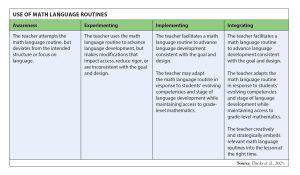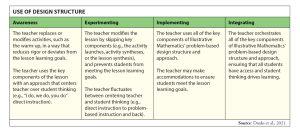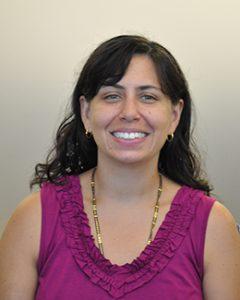IDEAS
‘Are we doing it right?’ Tool guides curriculum implementation.
By Kiran Purohit, Jennifer Kim, Liz Ramirez, Jennifer Wilson and Max Ray-Riek
Categories: Collaboration, Data, Educator evaluation, Evaluation & impact, Instructional materials/curriculumJune 2023
In New York City, as in many education systems, Algebra 1 is a gatekeeper course: Success in Algebra 1 helps students place out of remedial co-requisite courses if they enroll in the City University system, which includes almost half of students who attend high school in New York City. In spite of its importance, college readiness rates in math hover around 50% in New York City schools, effectively blocking students from higher-level math courses and college math.
Recognizing this pattern, New Visions for Public Schools is in the third year of supporting a network of 18 New York City public schools to address uneven student success in Algebra 1. One of the ways New Visions is helping schools achieve greater equity in algebra is by supporting them to use a shared curriculum. Implementing a high-quality curriculum is a key tenet of frameworks for curriculum-based professional learning that aim to improve all students’ access to rigorous and meaningful learning (Chu et al., 2022; Hirsh & Short, 2022).
''Implementing a high-quality curriculum is a key tenet of frameworks for curriculum-based professional learning that aim to improve all students’ access to rigorous and meaningful learning.'' #k12education Click To TweetAll schools in our network have opportunities to learn about and engage in coaching on the Illustrative Mathematics Algebra 1 curriculum — a course that is available for free online, with resources for K-12 instruction. We find that a shared curriculum facilitates conversations among teachers about lessons, math problems, and instructional routines.

But how do we know the shared curriculum is making a change and leading to improvement? In the early months and years of enacting a new curriculum, teacher practice will be uneven, and school leaders may be uncertain if instruction is improving. In fact, school leaders who don’t have experience teaching similar curricula might not recognize that poorly paced or otherwise messy implementation could be a sign that a teacher is right where they need to be in the early years of using a new curriculum.
To help leaders understand how the stages of implementation typically look and where their teachers are on that continuum, our network uses the Illustrative Mathematics Implementation Reflection Tool (Danks et al., 2021), a nonevaluative resource to guide classroom observations, reflection, and feedback about implementation. The tool supports educators across roles — including teachers, coaches, school leaders, and district staff — in navigating the predictable twists and turns of curriculum adoption and early implementation.
Implementing shared math curriculum? The @IllustrateMath Implementation Reflection Tool is a nonevaluative resource that spans educator roles to guide observations, reflection, and feedback. #TheLearningPro #MathEd #TeacherTwitter Click To TweetLearning walk observations
Imagine a learning walk in a small high school in New York City. Learning walks are a regular component of many professional learning communities, a structured way for a school’s staff and sometimes external partners to visit classrooms and get a sense of how instruction looks and feels. Rarely evaluative in nature, learning walks are intended to surface shared understandings of the nature of instructional practice.
The learning walk we are imagining involves visits to the classrooms of teachers in a 9th-grade team that has been working to adopt Illustrative Mathematics as its Algebra 1 curriculum. The team participated in professional learning during the summer, and it meets on a weekly basis to plan lessons and sometimes look at student work together.
As the learning walk team visits classrooms, focusing on Algebra 1 instruction, team members observe some notable differences from classroom to classroom:
- In the first classroom, the Algebra 1 teacher is familiar with the usefulness of math language routines to support multilingual learners. She enacts one such routine thoughtfully, but the pacing is quite different from the lesson plan: Rather than the 10 minutes recommended in the curriculum materials, the routine takes 45 minutes, and the teacher omits other components of the lesson.
- In the second classroom, the teacher uses all of the activities provided in the curriculum materials but does not apply the intended problem-based lesson structure, in which students collaborate to make sense of mathematics. Instead, he writes all of the problems on the board, and students take turns coming up to explain their solutions. There is little student-to-student discourse.
- In the third classroom, the teacher follows the pacing and problems in the instructional materials but skips the closing synthesis activity, the phase in which students’ thinking comes together and the teacher facilitates a summary of the main points of the lesson. Instead, the teacher provides students with a set of questions pulled from prior-year state tests. Students complete the items as independent practice and to demonstrate their understanding.

In all of these classrooms, teachers are clearly attempting to use the resources in their new curriculum, but they are doing so incompletely and in varying ways. Imagine being part of the leadership team at this school or in the role of a coach serving several schools like this one. What are the most important points to surface for this team as you think about feedback or next steps?
When thoughtful, ambitious leaders and supervisors visit a set of classrooms like these, they tend to focus on the following areas of feedback:
- Misalignment with the written curriculum: Observers may point out the ways in which instruction diverged from the lesson plans, thinking that deviations such as taking 45 minutes for a math language routine are problematic, no matter why the teacher made that choice.
- Classroom management: Observers often praise teachers for filling the whole period with instruction, believing this is a defining feature of strong instruction, even if it diverges from the expectations in the instructional materials.
- Test readiness: Observers concerned with demonstrating progress on an upcoming state test may be reassured to see students completing items from prior-year exams, even if it means the teacher skipped an essential activity from the instructional materials.
These typical focus areas reflect a lack of clarity on where to begin with implementing a new curriculum. Leaders do not always have the background to recognize what is most important when observing teachers’ early-stage practices, especially if they are not familiar with the content area — in this case, math.
They need a way to develop a clear understanding of how to respond in a content-specific, course-specific way, to lead shifts in instruction. Improvement in mathematics requires not just feedback on “readily observable aspects of instruction” but feedback on lesson-specific and content-specific pedagogy (Cobb et al., 2018, pp. 182-183).
Gaining clarity
In our network, we find that the Implementation Reflection Tool helps provide the needed clarity on where to begin. The tool has three sections, each of which focuses on implementation at a different level — school, team, and classroom. Each of these sections has a progression of practice — a set of levels from beginning to advanced, with descriptions of practice at each level, for multiple different aspects of curriculum use. The levels of practice move from left to right, with the ideal level of implementation on the right.
For our Algebra 1 learning walk scenario, we will focus on the progression of practice in classroom implementation. One of the indicators in this section is implementation of math language routines. Based on the progression of practice for this indicator (see the table on p. 61), the teacher who spent 45 minutes on math language routines is clearly demonstrating awareness.
An administrator using this tool would probably feel a sense of relief upon seeing the exact situation we observed described as a valid initial stage in the teacher’s practice. The administrator can also use the progression of practice to guide additional support for the teacher. As a next step, it would be helpful for a coach to work with the teacher on facilitating the routine more efficiently to ensure consistency with the goal and design.
As the teacher’s implementation gets stronger, she could also benefit from learning to incorporate more understanding of students’ language development, perhaps with the support of language teachers or interventionists in her building.
We can assess the practice of the other two teachers from the learning walk in a different progression of practice: use of Illustrative Mathematics’ design structure. All Illustrative Mathematics lessons follow a common format that supports students’ figuring out how to solve problems, then learning from one another’s work. This design structure is novel to many teachers.
The second teacher in our learning walk is in the awareness phase with the design structure (see table above “Use of design structure). He “replaces or modifies activities” in a way that is common for teachers starting out with the curriculum. Having students work out problems at the board undermines the collaborative work and problem-solving the lesson should foster.
However, since this mode of classroom instruction is familiar, the teacher may not recognize this as a misunderstanding of the instructional model, and he could therefore benefit from coaching on specific components of the problem-based lesson to move him along the progression of practice.
Finally, the third teacher from the learning walk is slightly further along in the same progression of practice. The instruction is at the experimenting level because the teacher “modifies the lesson by skipping key components” but does have some parts of the lesson that are squarely “centering student thinking.” This teacher may benefit from seeing examples of strong lesson syntheses to better understand their value and move her along to the implementing and integrating stages.
Supporting practice
In addition to observing and supporting individual teachers’ classroom practice, the Implementation Reflection Tool can help leaders think about patterns and trends. In our experience, this is a game-changer because it helps those giving feedback and designing professional learning respond based on teachers’ assets and strengths, with a view to a clear pathway ahead.
In the learning walk example, there are some clear patterns across classrooms. In the design structure table on p. 62, all three teachers are either in awareness or experimenting stages: using some of the key components of the curriculum materials, with varying degrees of integrity. To move to the next stages, all of the teachers would benefit from opportunities for shared sense-making about the learning goals for Illustrative Mathematics lessons and strategies for effective pacing. Moreover, they could collaborate and learn from one another’s specific strengths, such as pacing, use of routines, and fostering discourse.
One school in our network is using the tool to look at patterns in the math language routines. School leaders have theorized that a focus on these routines will foster student discussions and lead to improvements in students’ responses on constructed-response questions.
The math team and principal, along with the math coach, determined that the appropriate indicators of focus in the Implementation Reflection Tool should be the use of Illustrative Mathematics’ design structure and math language routines and engaging students in meaningful small-group discussions.
When they looked at patterns across classrooms, they were able to see that, while teachers were moving from awareness to experimenting in small-group discussions, students needed more discussion opportunities. Based on this finding, the team’s planning has shifted to include more math discussion opportunities and clarify department-wide expectations on math discussions. In this school example, using the Implementation Reflection Tool alongside an existing process for math team planning supported a focus on a high-leverage next step.
We also use the tool to look for patterns across the network. For example, following our first round of learning walk visits to classrooms, we noticed a pattern in the use of instructional routines, which are key features in the Illustrative Mathematics curriculum. While many teachers were enacting them, the instructional routines were taking up a large portion of the lessons. Routines designed to take up 10 minutes at the start of a lesson were dominating much of the class period.
Using the Implementation Reflection Tool, we recognized that this is a common misstep and identified ways to ensure that subsequent professional learning would focus on strategies for more effective pacing and lesson coherence. In this way, we used patterns we saw emerging across schools to shape the overall direction and strategies of the network.
Reflecting on curriculum with an effective tool facilitates conversations among teachers about lessons, pacing, student interaction, and instructional routines. #K12 #TeacherTwitter #Teaching Click To TweetMaking the most of the tool
The Implementation Reflection Tool is a powerful resource for learning, but it is important to consider the context and ways in which we use it. Teachers will only adopt tools like the Implementation Reflection Tool in the context of collaborative, trusting relationships because concerns about teacher self-efficacy can come into play.
Taking on a new curriculum makes even the most experienced teacher feel like a novice, and being designated at the awareness level on a curriculum tool could be demoralizing. A collaborative culture and an assets-based, nonevaluative approach to using the tool are essential.
In addition, we recognize that data collection can become burdensome. We have addressed it by weaving data collection into meaningful and fulfilling events like learning walks. We also allow teacher teams to opt into learning walks rather than making them a requirement of the network.
With strategies like these in place, we are hopeful about the potential for tools like the Implementation Reflection Tool to support and accelerate learning about instruction in classrooms, schools, and networks of schools.
Download pdf here.
References
Chu, E., McCarty, G., Gurney, M., & Madhani, N. (2022). Curriculum-based professional learning: The state of the field. Center for Public Research and Leadership.
Cobb, P., Jackson, K., Henrick, E., & Smith, T.M. (2018). Systems for instructional improvement: Creating coherence from the classroom to the district office. Harvard Education Press. cprl.law.columbia.edu/sites/default/files/content/CPRL-CBPL-Report-FINAL-0908.pdf.
Danks, S., Ramirez, L., Wilson, J., & Ray-Riek, M. (2021). The Illustrative Mathematics Implementation Reflection Tool (for Grades 6-12). Illustrative Mathematics.
Hirsh, S. & Short, J. (2022). Transforming teaching through curriculum-based professional learning: The elements. Corwin.
Categories: Collaboration, Data, Educator evaluation, Evaluation & impact, Instructional materials/curriculum
Recent Issues
EVALUATING PROFESSIONAL LEARNING
February 2024
How do you know your professional learning is working? This issue digs...
TAKING THE NEXT STEP
December 2023
Professional learning can open up new roles and challenges and help...
REACHING ALL LEARNERS
October 2023
Both special education and general education teachers need support to help...
THE TIME DILEMMA
August 2023
Prioritizing professional learning time is an investment in educators and...
















